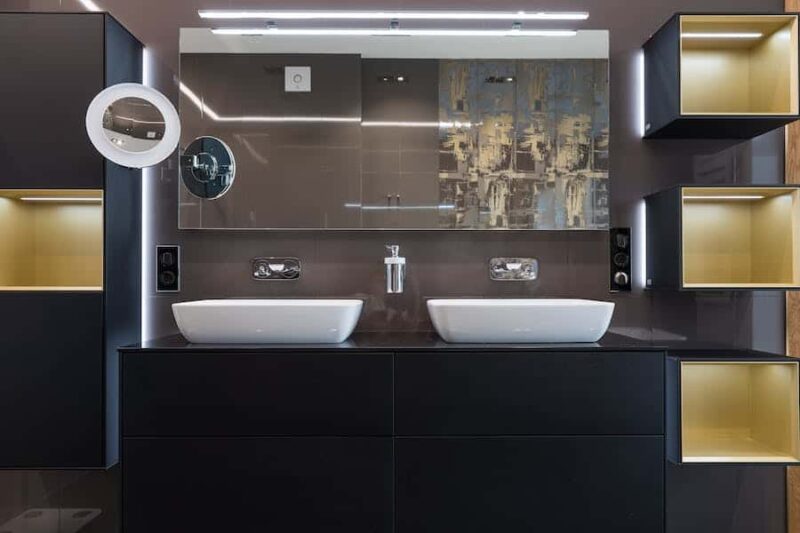The height of bathroom vanities is a critical factor that significantly influences the functionality and overall aesthetics of your bathroom. Choosing the right vanity height is not just about style; it’s about ensuring comfort and convenience in your daily routines. The height of your bathroom vanity can impact how easily you wash your hands, brush your teeth, apply makeup, and store essential items. It also plays a vital role in maintaining a visually appealing and harmonious bathroom design. In this comprehensive guide, we will explore why vanity height matters, when to consider different heights, how to measure and choose the right one, practical installation tips, and how to address common concerns to create the perfect bathroom retreat.
How Tall Are Bathroom Vanities?
Bathroom vanities typically range in height from 32 to 36 inches. This standard height provides a comfortable and practical surface for daily activities like washing hands and brushing teeth. However, there are variations, such as low-profile vanities (around 30 inches) for smaller spaces and comfort height vanities (around 36 to 42 inches) for taller individuals or those with mobility considerations. Floating vanities offer adjustable height options, allowing customization within this range.
Why Vanity Height Matters?
Vanity height matters for several reasons:
Ergonomics And User Comfort: The right vanity height ensures comfortable use for everyday activities like washing hands, brushing teeth, and applying makeup. A well-matched height reduces strain and discomfort.
Aesthetics And Proportionality: Vanity height influences the overall visual balance of the bathroom. Proper height selection ensures that the vanity fits harmoniously into the bathroom’s design, contributing to a cohesive look.
Storage Considerations: Vanity height impacts the space under the sink. Choosing the appropriate height ensures that you have enough storage space and that it’s easily accessible.
Accommodating Various Users: Different individuals in your household may have varying height requirements. Selecting an adaptable height or customizing the vanity to suit everyone’s needs ensures inclusivity and user-friendliness.
When To Consider Different Vanity Heights?
Consider different vanity heights based on various factors:
- Standard Vanity Height (32-36 inches): Suitable for most bathrooms and users. Ideal when there are no specific height requirements or constraints.
- Low-Profile Vanities (Around 30 Inches): Ideal for small bathrooms or to create a modern, streamlined look with a lower profile.
- Comfort Height Vanities (36-42 inches): Recommended for taller individuals or those with mobility issues, providing a more comfortable and accessible surface.
- Floating Vanities: Adjustable in height, making them versatile for accommodating different users or achieving a specific design aesthetic. Choose the vanity height that aligns with your bathroom’s space, your household’s needs, and your desired style, ensuring optimal comfort and functionality.
How To Measure And Choose The Right Vanity Height?
To measure and choose the right vanity height, follow these steps:
Measure The Existing Vanity: Measure the height of your current vanity from the floor to the countertop. Note down any backsplash or additional height elements.
Consider Household Needs: Determine who will primarily use the bathroom. Take into account the height of family members and potential guests. Consider any special requirements, such as accommodating children or individuals with mobility challenges.
Custom Vs. Pre-Made Vanities: Decide whether you want a custom-made vanity or a pre-made one. Custom options allow you to choose the exact height, while pre-made options come in standard heights.
Test The Height: If possible, visit showrooms and try out vanities of different heights. This hands-on experience will help you identify the most comfortable height for your needs. Alternatively, create cardboard mock-ups to simulate different heights in your bathroom space.
Finalize Your Choice: Based on your measurements, household needs, and testing, select the vanity height that best suits your bathroom and provides optimal comfort and functionality. Choosing the right vanity height ensures a comfortable and functional bathroom space that caters to your specific requirements.
Practical Installation Tips For Your Bathroom Vanity
- Hire A Professional: Consider hiring a professional contractor or plumber for the installation, especially if you’re not experienced with plumbing or carpentry work. This ensures a safe and expertly installed vanity.
- Plumbing Alignment: Ensure that the plumbing fixtures (drain and supply lines) are properly aligned with the vanity’s cutouts. Make any necessary adjustments to match the vanity’s configuration.
- Leveling: Use a level to ensure that the vanity is installed perfectly horizontally and vertically. This prevents any issues with water drainage and provides a visually appealing result.
- Wall Mounting: If you have a floating or wall-mounted vanity, ensure it is securely attached to the wall’s studs. Use appropriate wall anchors and screws to provide strong support.
- Floor Attachment: If your vanity rests on the floor, secure it to the floor to prevent any movement or wobbling. Use shims if necessary to level it on uneven floors.
- Plumbing Connections: Carefully connect the plumbing fixtures, including the sink drain and faucet, following the manufacturer’s instructions. Ensure there are no leaks and that everything functions properly.
- Sealant Application: Apply a silicone sealant along the edges where the vanity top meets the wall to prevent water seepage. Also, seal around the sink’s rim to ensure a watertight seal.
- Hardware Installation: Attach any cabinet handles, knobs, or pulls according to your design preferences.
- Final Inspection: After installation, inspect the vanity thoroughly to check for any loose parts, uneven surfaces, or issues with plumbing connections. Make any necessary adjustments or corrections.
- Cleanup: Clean up the workspace, removing any debris, excess sealant, or packaging materials to leave your bathroom looking neat and tidy. By following these practical installation tips, you can ensure a well-secured and properly functioning bathroom vanity that enhances both the functionality and aesthetics of your bathroom.
Conclusion
In conclusion, selecting the right vanity height for your bathroom is crucial for optimizing both functionality and aesthetics. Whether you opt for a standard height, a low-profile design, a comfort height, or a floating vanity, careful consideration of your household’s needs and the space available is key. Proper installation is equally important, ensuring stability and preventing issues down the line. By making informed choices and following best practices during installation, you can create a bathroom space that is not only visually pleasing but also comfortable and user-friendly for everyone in your home.
FAQ’s
What Is The Standard Height For A Bathroom Vanity?
The standard height for a bathroom vanity is typically between 32 to 36 inches.
Are There Alternatives To Standard Vanity Heights?
Yes, alternatives include low-profile vanities (around 30 inches) and comfort height vanities (36-42 inches).
Can I Customize The Vanity Height?
Yes, you can customize the vanity height if you choose to have a custom-made vanity.
How Can I Test The Right Vanity Height For My Bathroom?
Visit showrooms to try out different heights or create cardboard mock-ups in your bathroom.
Do I Need Professional Help For Vanity Installation?
It’s advisable to hire professionals, especially if you lack plumbing or carpentry skills, to ensure a safe and secure installation.








